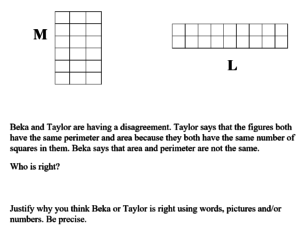Solve real world and mathematical problems involving perimeters of polygons, including finding the perimeter given the side lengths, finding an unknown side length, and exhibiting rectangles with the same perimeter and different areas or with the same area and different perimeters.
[divider] [/divider] Students are able to…
- Measure to find the perimeter of shapes on a geoboard, graph paper, and real world objects.
- Use a picture to explain how to determine the perimeter when there is an unknown side.
- Understand the difference between perimeter and area.
[divider] [/divider] Students are able to…because teachers:
- Provide hands-on experiences with color tiles, geoboards and measuring to find the perimeter of objects.
- Provide opportunities for the students to find the side lengths of rectangles given only one side length and the perimeter.
- Ask students to talk about, write about, draw diagrams and use numbers to find the perimeter given a length and width or find a missing dimension given the perimeter and length of one side.
[divider] [/divider] Questions to ask students:
- Explain how you would find the perimeter of a shape.
- Sample answer that indicates understanding: I can measure the distance around the shape and add them together to find the perimeter.
- Sample answer that indicates an incomplete understanding or a misconception: I can make squares inside the shape and count the squares.
- How can you determine the perimeter if you are missing a side?
- Sample answer that indicates understanding: I can figure out the missing side by adding the sides that I know and subtracting it from perimeter of the shape.
- Does every rectangle with the same area have the same perimeter? Does every rectangle with the same perimeter have the same area? How do you know?
- Sample answer that indicates understanding: No, I can have rectangles with the same area but different perimeters, and I can have rectangles with the same perimeter but different areas. For example, a 2×2 rectangle has an area of 4 square units, and a perimeter of 8 units; and a 1×4 rectangle also has an area of 4 square units, but the perimeter is 10 units. They have the same area, but different perimeters. A 2×2 and a 1×3 rectangle both have a perimeter of 8 units, but one has an area of 4 square units and the other has an area of 3 square units; they have the same perimeter but different areas.
[divider] [/divider] FSA Notes
Cognitive Complexity Level: 2 – Basic Application of Skills and Concepts
Achievement Level Descriptors:
2- finds the perimeter of a rectangle given the side length
3- solves real-word and mathematical problems involving perimeters of polygons
4- finds unknown side lengths involving perimeter; exhibits rectangles with the same perimeter and different area or with the same area and different perimeter
5- constructs rectangles that have the same perimeter but different area and the reverse
Assessment Limits:
For items involving area, only polygons that can be tiled with square units are allowable.
Dimensions of figures are limited to whole numbers.
All values in items may not exceed whole number multiplication facts of 10 × 10.
Items are not required to have a graphic, but sufficient dimension information must be given.
[divider] [/divider] Additional Resources:
Additional in depth content knowledge
Blog Post: Understanding Perimeter
LearnZillion Videos:
Find perimeter with missing side lengths
Use a Chart to Understand how Rectangles can Have the Same Perimeter with Different Areas
[divider] [/divider] Sample Formative Assessment Task:
[divider] [/divider] Resources/Tasks to Help your Child at Home:
Give your child the opportunity to measure to find the perimeter of various flat surfaces around the house.
Ask your child about dimensions of different shaped objects. What is the length of this table? What is the width? How could we find the perimeter of this table if we knew the length and width?
LearnZillion Videos:
- Find the Perimeter of a Polygon https://bit.ly/2JyFS2E
- Find the Perimeter of a Square or Rectangle by Adding Side Lengths https://bit.ly/2msiRFN
- Find the Perimeter of a Polygon with more than 4 Sides https://bit.ly/2uKDBfx
- Use a Chart to Understand how Rectangles can Have the Same Perimeter with Different Areas https://bit.ly/2LkFUkx

